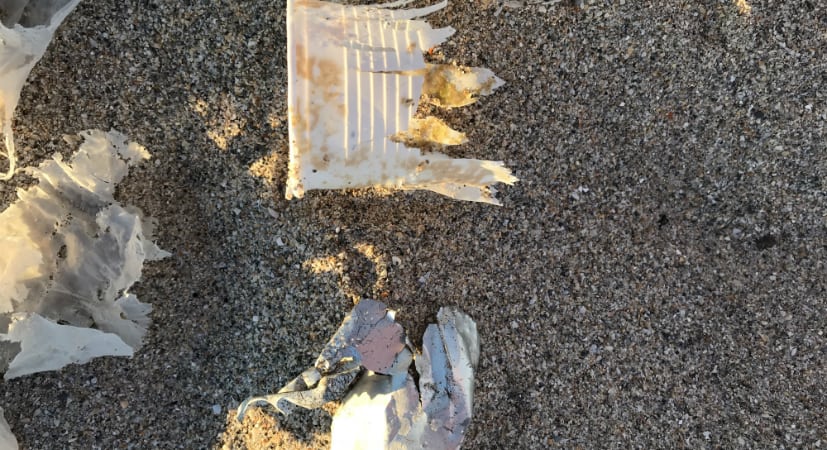The concern over microplastics in our environment didn’t stop with the microbead ban in 2015. In fact, this concern has only grown and will continue to grow as scientists struggle to find funding for this crucial research. What do we know now about microplastics? Here’s a brief recap and update.
In 2014, pre-microbead ban, Sherri Mason, a chemist at the State University of New York at Fredonia, and her undergraduate students tagged along with sports fishermen on Lake Erie, offering to fillet their catches, if they could collect the fish innards. Mason and her students were searching for microplastics, small pieces of plastic debris (5 mm or less) resulting from the disposal and breakdown of consumer products and industrial waste. In nearly every fish they filleted, Mason and her team found microplastics, including tiny plastic pellets called microbeads.
Mason’s work and that of her collaborators resulted in an uproar with many consumer groups demanding, “Ban the bead.” Cosmetic companies largely used microbeads as an exfoliant in facewashes, body scrubs, and toothpaste, a purpose that many safer, alternative materials could fulfill. The Microbead-Free Waters Act of 2015 amended the Federal Food, Drug and Cosmetic Act to “prohibit the manufacture and introduction or delivery for introduction into interstate commerce of rinse-off cosmetics containing intentionally-added plastic microbeads.” The ban on the introduction of certain cosmetic products with microbeads into interstate commerce doesn’t begin until July 2019, so it’s possible some of these products are still in stores for purchase (look for “polyethylene” in the ingredients).
Although Mason’s team collected microplastics and microbeads in the fish innards, the most abundant source of plastic they found were tiny plastic fibers, called microfibers, that are manufactured into synthetic textiles, including nylon, rayon, polyester, acrylic and spandex. Microfibers are among the most abundant type of microplastics scientists find while studying the Great Lakes and its tributaries, representing 85 percent of plastic pollution found on the shorelines around the world. To understand the extent of the problem, look in your closet. According to Mason, approximately 1,900 fibers could break off one piece of synthetic clothing each time it is washed. Now multiply that number by each piece of synthetic clothing you own.
Microfibers are of particular concern because of the overwhelming abundance found on land, in water, in rural areas, in urban areas—everywhere. According to a study by Mason and colleagues from 17 wastewater treatment plants around the country, each treatment plant releases four million pieces of plastic per day, and nearly 60 percent of those are microfibers. Aside from being released through water or sludge by a wastewater treatment plant, microfibers can be released into the air as lint from dryer vents or settle out of the air as they shed from everyday use of clothing, carpets and other textiles.
This emerging field of microplastics research highlights the fact that the products we make don’t disappear. Microplastics have been detected in our food chain through fish, shrimp, mussels, sea salt, honey and other foods. Microplastics are floating through the air as microfibers, and plastic pollution is embedding into the Earth’s geology as a new rock form geophysicists are calling plastiglomerate.
Many groups raising awareness about microplastics are also searching for potential solutions. Patagonia announced it would sell the Guppy Friend and The Rozalia Project will soon release the Cora Ball; both products are designed to catch circulating fibers from clothing throughout the wash cycle. Many activist groups are calling for washing machine and dryer manufacturers to install filters to trap microfibers while in use.
Similar to the public’s uproar over microbeads, the concern over microfibers is only a part of the larger problem. Tackling microplastics as a whole would mean we, as consumers, must challenge current industry standards and operations by changing our behavior in the way we use plastic and how we dispose of it. Good starting points for consumers? Avoid single-use plastics (commonly known as “disposable” plastics) such as plastic water bottles, bags, straws, Styrofoam and plastic utensils. Ditch single-use items for reusable for products like coffee mugs, water bottles, take-out containers and serviceware. Understand materials that are and are not recyclable in your community. And most importantly, stay informed and be a smart consumer!
About the Author
Stacy Albin has completed the Solid Waste District’s required coursework for the Master Recycler program and continues to work on the volunteering component. Stacy is formerly a resident of Cleveland.
POSTED ON:
